
The Regia Marina like the Kriegsmarine did not brushed out the torpedo boat class as obsolete. On the contrary, this smaller and cheaper type could replace destroyers well in the confined waters of the central Mediterranean, notably for escort missions. In addition to all the vintage WW1 vessels reclassified as Torpedinieri, from 1933 a new breed of modern torpedo boat was created, the Spica class, followed by the Pegaso and in WW2 Ciclone and Ariete class, seeing a lot of action and heavy losses, including in Kriegsmarine’s hands in 1944-45.
Why still using torpedo boats in WW2 ?

Castore in 1942 (USMM)
The appearance of the torpedo in the 1870s trigerred several generations of very interesting carrier ships and boats. In the 1860s already, a “torpedo” was a simple expmosive charge detonated by cordon at the end of a spar. With Whitehead’s innovation, the search for a light, fast and nimbler carrier trigerred the apparition of the first “torpedo boat”, but cruisers, battleships also adopted it in the 1880s. The latter renounced it after Jutland but cruisers still had it in the cold war, and in fact they are still on the menu today in an ASW form.
In the interwar, all major ships types were capped by the Washington treaty signed by major major powers of the time, less Germany capped by the Versailles treaty. Battleships were forbade for ten years and the remainder capped in tonnage, Cruisers also by singular and global tonnage plus armament, as well as destroyers, limited to 1500 tonnes standards, which corresponded to the British own upper limit. But the treaty also left many loopholes, a 10,000 tonnes aicraft carrier was not one as the tonnage seemed unrealistic, Navies could built heavy cruisers to compensate for the loss of battleships, they could also modernized theirs, no limit was given to submarine tonnage, nothing was said about fleet auxiliaries, and crucially for what we are interested about, nothing was said about “naval dust” and torpedo boats with they below 800 tonnes displacement.
If the 1930 London naval conference and treaty adressed most of these issues, it still said nothing about torpedo boats, albeit destroyers were now limited to 1,850 tonnes and 5.1 inches guns. This means below this tonnage, a “torpedo boat” was seemingly acceptable, within the limits of global tonnage (16% of it was devoted to destroyers and over 1,500 tonnes vessels), which were for Italy 175,000 tonnes, like France. Thus, this left them in theory outside the global tonnage for all intents and purposes. For Italy this had two consequences: Allowing to keep in service a large number of vintage WWI destroyers, reclassed as “torpediniere” and place them out of the global tonnage, and built new ones, or a modernized type.
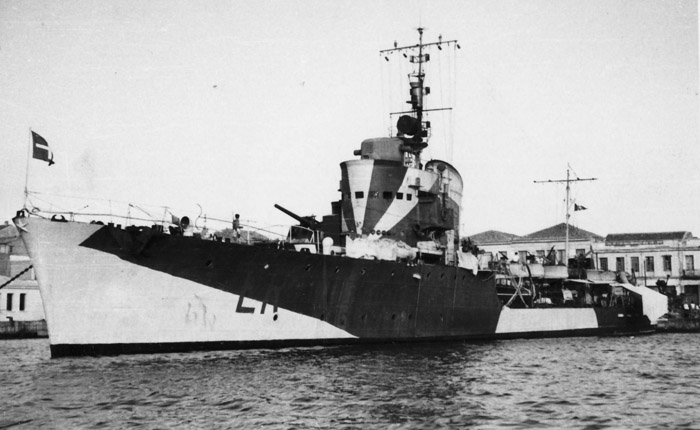
Lira 1942
Destroyers were so much more useful than early TBs, condemned to coastal defence, they just had much better seaworthiness, greater capabilities and left open the belowr 600 tons to unlimited construction. This, the French, Italian, Japanese and German Navies developed torpedo boats about 70 to 100 m long with this standard tonnage (“cheating” when posible to make them artificially lighter). They were armed with two or three 100 mm guns (4 inches) well velow the 5.1 inches authorized and of course torpedo launchers. They were still fast and could be also useful for ASW patrol, being equipped with depht charges.
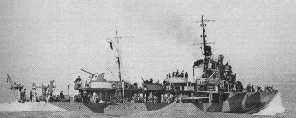
Among smaller navies, the Royal Norwegian Navy relied on torpedo boats and with their prewar Sleipner-class “destroyers” created a very potent torpedo boat. On their side, the Italian Spica-class was rather large and ended a bit as a destroyer escort. The Germans replaced their own interwar models in wartime by 1,700 tonnes types Flottentorpedoboot as the former were found wholly inadequate. The whole category was reclassed as “corvette” under NATO new designations. The “large type” disappeared for good as such but smaller “torpedo boats”, the Motor Torpedo Boats or “MTB”, also an invention of WWI, soldiered on in WW2 and were still around until the late 1960s around the world’s navies before being replaced by the larger missile-armed FACs.
Italy’s postwar Torpediniere
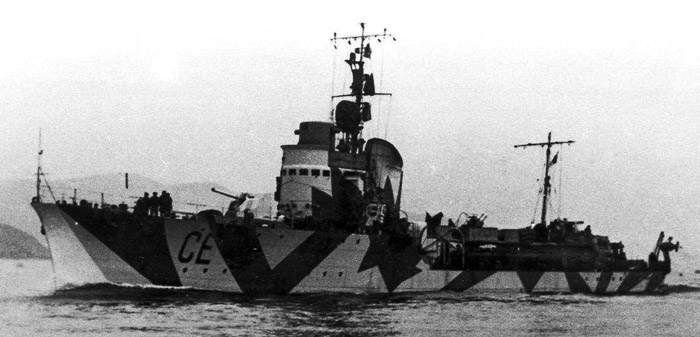
Torpedo Boat in 1942 (codename CE)
Italy’s own torpedo boat (the “torpediniere”) started quite soon as Whitehead produced Luppis’ invention, an Austro-Hungarian engineer, in Italy’s backyard. Developed into nine classes from 1878 after many experimental small crafts, the type really gained traction in the 1900s with the Sirio, Pegaso, Orione, and the prototype Gabbiano ending with the successful mass-built PN class which made the bulk of Italian WWI torpedo boats. In 1918 however, the TBs shown thaat their seaworthiness and light armament made them not so useful in their actual form. They were justified in the context of adriatic operations, but the Regia Marina really concentrated on destroyers postwar.
After the Washington treaty was signed, it was not long before new classes of destroyers were designed, in the mid-1920s. In the meantime, the bulk of the destroyer force counted on the numerous pre-WWI and wartime destroyers of the “3-tubes” of the Indomito, Audace, Pilo, La Masa, Sirtoti classes at least had a forecastle instead of the typical turtleback bow of previous vessels, and had some usefulness despite their small tonnage. Until 1938 these were all still designated as destroyers, while still well under the tretay limits. However at that stage, the Regia Marina planned a much larger class of destroyer, the Soldati class, for mass-production, already rated at the maxium 1700 tonnes, and the new generation, the Medaglie d’Oro on it’s way was even larger at 2,300 tonnes standard.
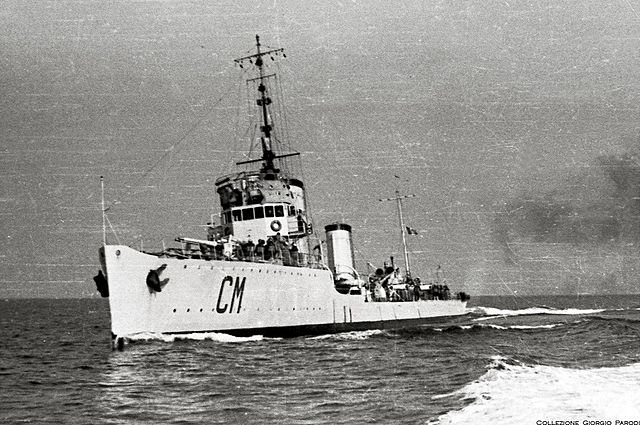
Italian former destroyer Catalafimi in 1940 during Operation Vado
Thus, decision was taken to “free destroyer tonnage”, by redesignating all WWI destroyers as torpedo boats, and this included the 1917-1921 Palestro and Curtatone classes, eight two-funneled, fast and well armed vessels of high standard. In 1939, Italy prepared for war and many of these TBs were upgraded with AAn sonars and depth charges, given to coastal divisions and especially along the Italian’s west coast, facing French trade routes with North Africa, the riveria, and the Thyrrenian sea.
WWI Italian Torpedo Boats in 1940
 Indomito class (1913)
Indomito class (1913)
Ardito, Insidioso
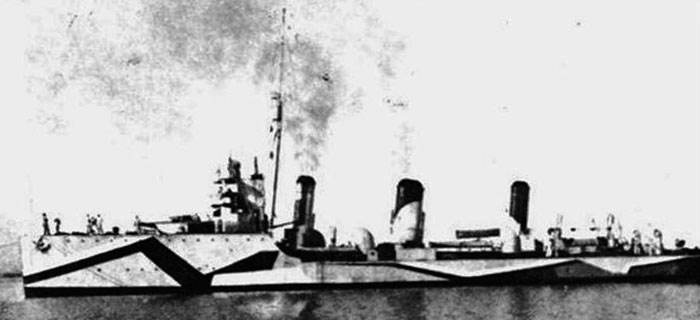
Ardito of the Indomito class in 1942
These 1913, 760 tons ships were all reclassified as TBs from 1929. They were all discarded in 1931-37 but Insidioso, although discarded in 1938 was not broken up, and was brough back in service after the war erupted. In 1941 she lost a funnel, and was taken in hands and refitted with a single 102mm/45 gun, and a modern AA comprising four single 20mm and two twin 13.2 mm HMG mounts. She was used for many duties, starting as a target for submarines in Pola, then an Adriatic escort vessel. Captured in 1943 she was renamed TA21, she was rearmed in German standard (Flakvierling mounts, 2×4 plus a single mount, 2x 102 mm). She was damaged by a British plane in August 1944, was repaired and then served until 5.11.1944 when she was sunk by an American aerial torpedo.
 Audace (1916)
Audace (1916)
(no image)
Audace, the first of this name was sunk in 1916. The second was transferred from the Japanese, then under construction at Yarrow yards in Great Britain. This vessel was reassigned to the fleet in 1940 after serving as a radio control vessel. She lost her torpedo tubes and won 20 single 20 mm AA guns. Inactive in 1943 in Venice, she was captured by the Germans and was sunk in action in November 1944 under as TA 20 near Zara, by two British destroyers, HMS Wheatland and Avon Vale.
 Pilo class (1916)
Pilo class (1916)
Rosolino Pilo, Giuseppe Cesare Abba, Giuseppe Dezza, Giuseppe Missori, Antonio Mosto, Ippolito Nievo, Fratelli Cairoli, Simone Schiaffino
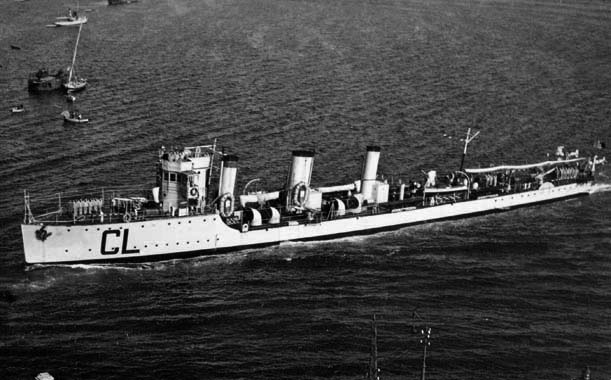
Fratelli Cairoli
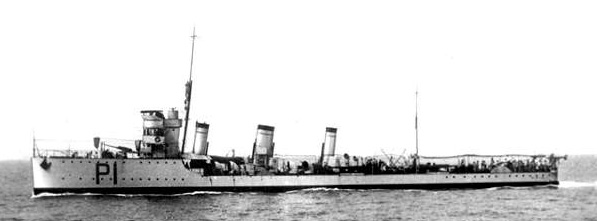
Official photo of Rosolino Pilo
These 885 tons ships were all in service, although reclassified as torpedo-boats. Nievo was the exception, being discarded in 1938. they were rearmed with two 102mm guns, six 20mm AA guns, four AA heavy machine guns, and keeping half of their torpedo tubes. They served as escorts. The first two and Mosto survived the war and wer discarded in the 1950s. F. Nullo (Fratelli Cairoli from 1921 hit a mine off Libya, on 23 September 1940. Schiaffino seized the Greek steamer Athinai off Messina on 20 October 1940 and was sunk by an Italian mine off Cap Bon 24 April 1941. Giuseppe Dezza (former Bronzetti pre-1921) was scuttled 16 September 1943 and became TA35 from 9 June 1944, sunk by mine 17 August 1944 refloated and scuttled 3 May 1945. Missori was captured by Germany 10 September 1943 as TA22, scuttled 3 May 1945.
 Sirtori/La Masa classes (1917-19)
Sirtori/La Masa classes (1917-19)
Giuseppe Sirtori, Giovanni Acerbi, Vincenzo Giordano Orsini, Francesco Stocco * Giuseppe La Masa, Giacinto Carini, Angelo Bassini, Nicola Fabrizi, Giuseppe La Farina, Enrico Cosenz, Giacomo Medici.
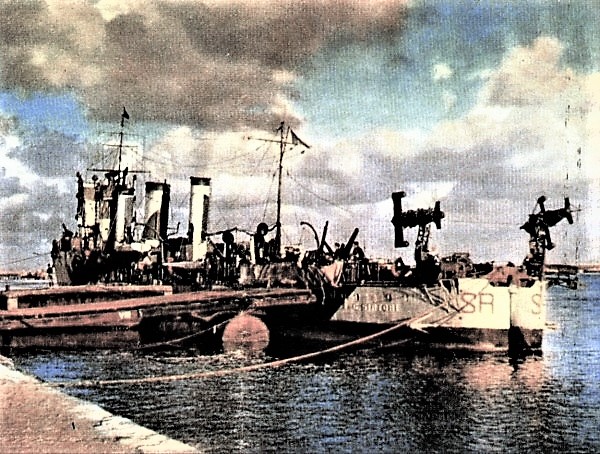
Sirtori in 1942
The destroyers of the Sirtori classes (4 ships, 1917), and La Masa (8 ships, 1917-18-19), were assigned to the same tasks. Very close to the Pilo, they received between 6 and 8 guns of 20 mm AA during the war. Acerbi was sunk in 1941 by the RAF but the others for the most part by German or allied planes and/or captured: Giuseppe Sirtori was stranded on a badly damaged beach on September 14, 1943 after a German air raid near Corfu, scuttled. Giovanni Acerbi was damaged beyond repair by a RAF attack on Massawa in early August 1940 and finished off on 4 April 1941. Vincenzo Giordano Orsini also was scuttled at Massaoua on April 8, 1941. Francesco Stocco was sunk by German bombers near Corfu on September 24, 1943.
Giuseppe La Masa was captured on 9 September 1943 but scuttled on the 11th. Giacinto Carini survived the war and became a minesweeper in 1954-1958. Angelo Bassini was sunk on 28 May 1943 in Livorno after an USAAF raid. Nicola Fabrizi survived the war (minesweeper in 1954-1957), Giuseppe La Farina was sunk on 4 May 1941 after hitting a mine off the Tunisian coast. Enrico Cosenz (Agostino Bertani) was scuttled in the Adriatic near Lastovo on 27 September 1943 after been heavily damaged by the RAF. Giacomo Medici was sunk in Catania on 16 April 1943 by an American air raid.
 Generali class (1921)
Generali class (1921)
Generale Antonio Cantore, Antonio Cascino, Antonio Chinotto, Carlo Montanari, Marcello Prestinari, Achille Papa.
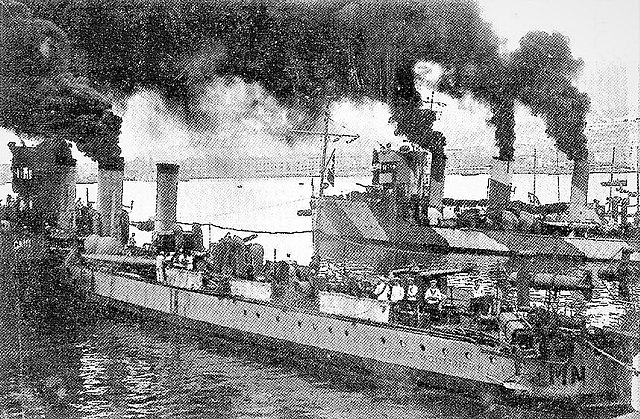
Montanari in 1942
The destroyers of the Generali class (6 units, 1921), very close to La Masa, but launched and completed well after the war. They received two 20 mm guns and some additional Breda 13.2 mm twin machine guns. They were all sunk in combat, except Cascino and Montanari, both scuttled. Cantore hit a mine off Ras el Tin in Libya, and sunk 22 August 1942. Cascino was scuttled 9 September 1943, Chinotto hit a mine off Palermo, 28 March 1941. Montanari was scuttled on 25 April 1944, Prestinari hit a mine near Sicily on 31 January 1943 and Papa was captured by the Germans, unnamed and eventually sunk 25 April 1945 after seeing little service.
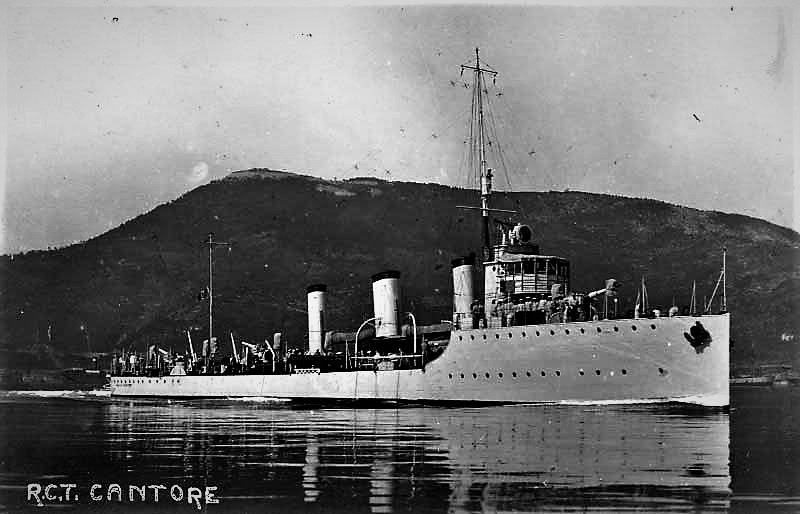
Generale A. Cantore
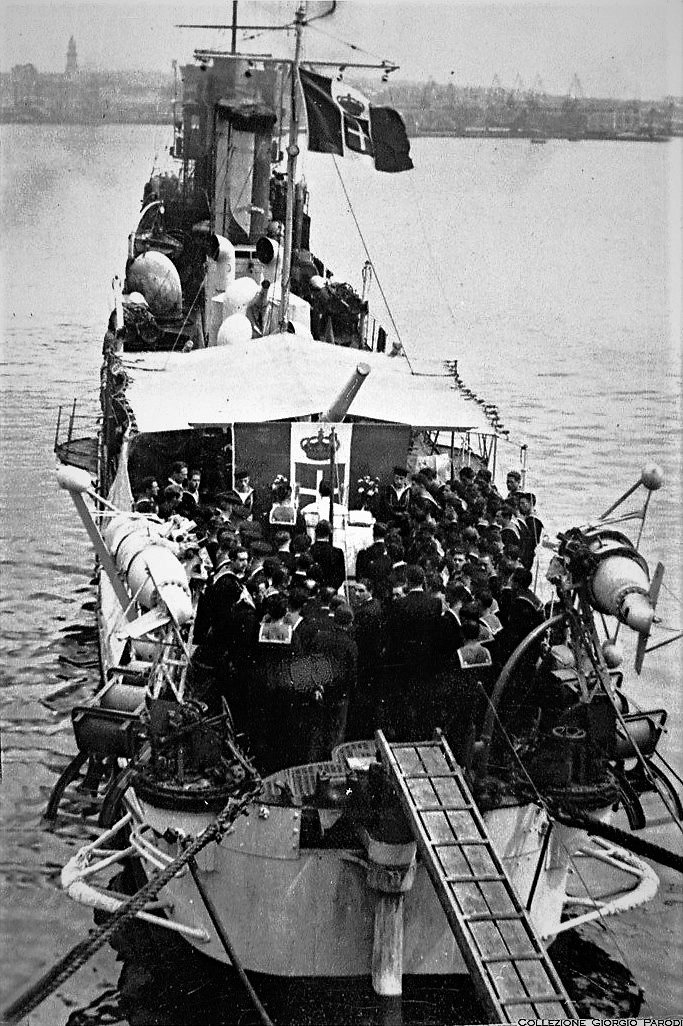
Rear view of Achille Papa showing her aft deck, DCs and paravanes.
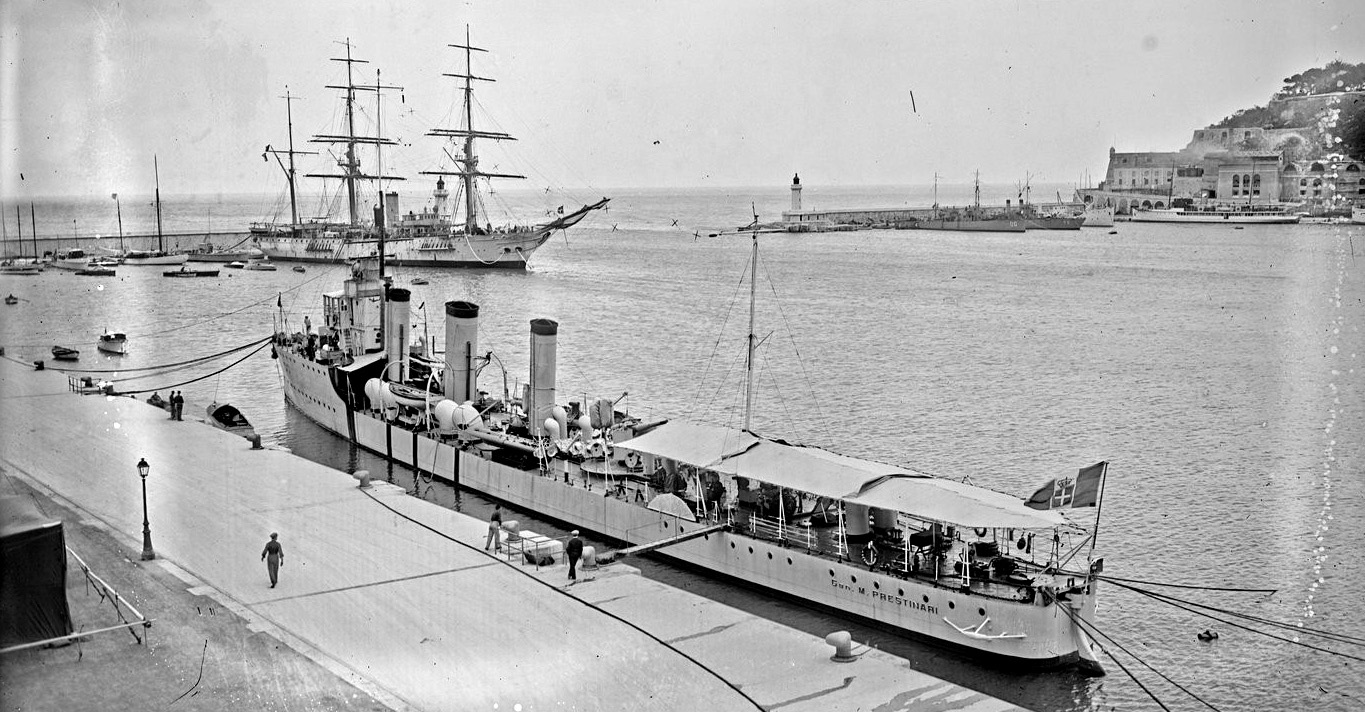
Superb photo of Prestinari in Monaco, 1923 (agence Rol).
 Palestro class (1921)
Palestro class (1921)
Palestro, Confienza, San Martino, Solferino
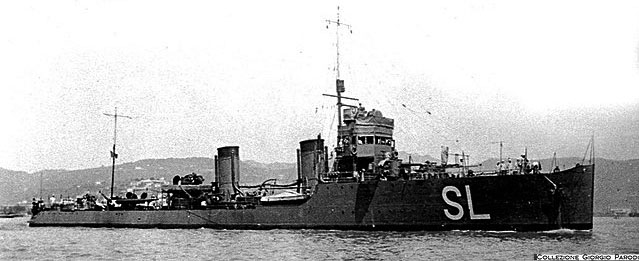
RN Solferino
A brand new type of destroyer based on the Audace, itself Japanese in design. Two funnels, four Schneider-Arsmtrong guns, twi 75mm/40 AA and two twin 45 cm tubes plus mines, for 32 knots they could cover 1970 nm. Started but completed in 1921 and of the eight originals, only four completed in 1921-22. TBs from 1938, the AA was modernized like the Curtatone (see later).
Palestro (PT) was sunk by the British submarine HMS Osiris off Durrës, Albania, on 22 September 1940. Confienza (CF) collided with the auxiliary cruiser Capitano A. Cecchi off Brindisi on 20 November 1940 and sank as a result.
San Martino (SM) was captured by the Germans at Piraeus, Greece, on 9 September 1943, becoming TA17, then hit a mine on 18 June 1944, refloated then sunk in an air raid on 18 September 1944 while under repair, scuttled at Salamis on 12 October 1944. Solferino (SL) had the same fate and became TA18, badly damaged by gunfire during a duel with HMS Termagant and Tuscan off Skiathos (Aegean) and her captain ran aground near Volos, her crew finishing her off.

Profile of Palestro class in 1942
 Curtatone class (1921)
Curtatone class (1921)
Curtatone, Catalafimi, Castelfidardo, Monzambano
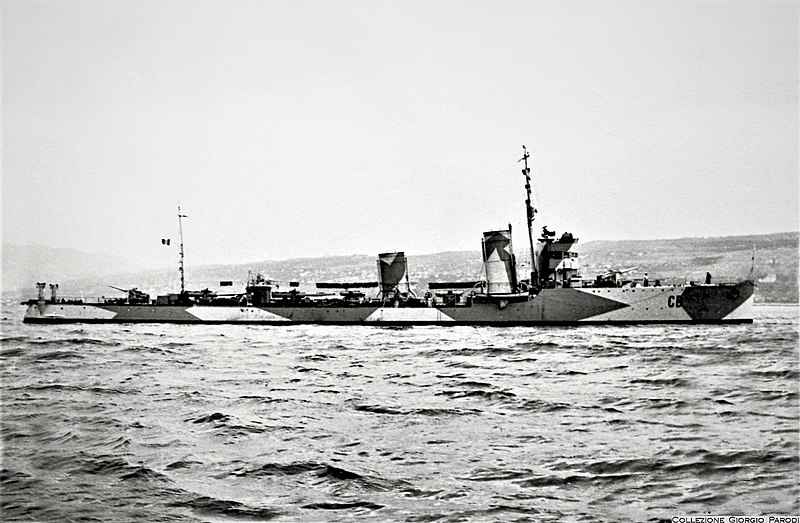
Castelfidardo 1942
The Curtatone class were the first post-war Italian destroyers, using also for the first time twin mountings for their main guns. Ordered at the same time as the Palestro-class in 1917, construction was postponed due to steel shortages so the design was modified to incorporate was lessons. Their hull were also lenghtened by by 4.5 metres (14 ft 9 in). Started in 1920-21, launched 1922-23, they were commisioned in 1923-24 and all came from Orlando yard in Livorno.
In 1938 they were all reclassed as torpedo boats. They were modernized to perform escort missions during WW2. The twin mounted were replaced by single mounts and their triple 450-mmm (18 in) torpedo tubes replaced by twin 533 mm (21.0 in) ones, and light AA guns added in place of their old 76 mm (3.0 in)/40 DP guns: 2 Scotti-Isotta-Fraschini 20mm/70 Modello 1939 and two 8 mm Breda AA MGs.
As such, they took an active part into the fight, Curtatone being sunk by the explosion of one or two mines in Saronikos. Calatafımi’s and Monzambano’s aft twin gun mount was replaced by one single gun only by 1942 and Calatafimi’s had her 2-2lin TT installed at that date also. Both Catalafimi and Castelfidardo were catpured by the Germans in September 1943 in pareus, became T19 and T16 and were sunk both in the Aegean in 1944. Monzambano survived the war and was discarded in 1951.
Interwar development for new torpedo boats

Sirtori in 1942
After the London Conference still allowed it in 1930, the Regia Marina staff started to look at the “below 800 tonnes” category for a new generation of torpedo boats, having a much longer range and seaworthiness compared to it’s numerous MAS squadrons. Thus, soon after the Curtatone were reclassified as TBs in 1929, the Regia Marina started to look on a new category of modern torpedo boat, looking how to “scale down” a contemporary destroyer and foreign designs.
In 1930, the staff inded commissioned Generale del Genio Navale Gustavo Bozzoni of the Comitato Progetto Navi to study a new class of escort ships with the aim of replacing the decommissioned destroyers reclassed as torpedo boats, notably the numerous “tre pipe” approaching anyway their age limit as warships.
At first studies concentrated on below-600 tons category and the general staff imposed engineers that upper limit, of course for standard displacement. With regard to the armament, speed, autonomy however, their required remained pretty high, even though the displacement stayed this stringent wall. The Comitato Progetto Navi then proposed to remove a single the 100mm/47 gun of the four of usual destroyers, to just three, and later two became the standard.
These works ended in 1931 with an approved basic design, and thus, two prototypes were ordered for comparative tests, but to the same BSN Yard of Naples. Their definitive design was completed in 1932 and approved by the general staff, after which construction commence with the aim as providing the Regia Marina with a first mass-built class of 32 vessels, to be reparted between various yards: BSN Napoli, but also Ansaldo, Sestri Ponente, CT, Riva Trigoso, and CNQ, Fiume.
The two prototypes Spica and Astore, laid down on May 24, 1933, had a standard displacement of around 630 tons and thus were still a bit above. However soon, denunciation of the Treaty of London by Berlin and Tokyo eventually resulted for Musolini to also abandon that limit. The following Alcione series thus, reached an uncomplexed standard displacement of 679 tons. And it was just the start.
Mussolini indeed had grand plans for them, based on their extected speed of 35 knots and 1,728 nautical miles at 16 kts (3,200 km a 29,63 km/h) enabling them a fairly large action radius, well able to roam at will the Adriatic and Thyrrenian sea, reaching the French riviera for a short high speed attack run from Genoa, patrolling the whole Italian coastal area, the african coast and later provide a valuable defence of East Africa where a full squadron could without doubt deter any British incursion.

After two prototypes, Spica and Castore (they were soon adopt star names, like their WWI forebears), would later led to the construciton of 32 torpedo boats, while already in 1934, engineers were given leeway to study the next iteration, Bacini e Scali Napoletani, Napoli aldo showed an interesting design, and they trusted the engineering team to provide blueprints of a larger version, this time free to reach 850 tonnes standard, provided better endurance, beyond 3,000 nm if possible. They dropped a 100 mm gun, but gained six torpedo tubes, still of the “light” airborne model, and extra AA and ASW firepower. They were slightly less powerful and rea-rated as 28 knots ships, but oil capacity was doubled. Thus, they were designated at first as “escort destroyers”. However in 1938 as completed, they were re-rated as “escort torpedo boats” (scorta torpediniera). Only four were made.
The last Spica class were completed in 1938 and at that stage, a “vacancy” allowed some leeway before proceeding to possibly a new design. However in June 1940 Mussolini declared war on France and Britain, and thus, the admiralty was tasked to design was wartime naval plan. Torpedo Boats made a comeback due to their low coast and potential. Studies immediately started on an improved version of the Pegaso, about 70% heavier, and reaching 1,625 tonnes fully loaded. For the rest, not many changes, apart that torpedo armament was lowered, as ASW armament, but AA augmented considerably.
These sixteen vessels were even slower at 26 knots and were considered mostly were as escort convoys and ASW patrollers during the war. But as the war progressed in 1942 the General staff wanted a ship to protect their convoys in a more agressive way, as well as dealing with enemy convoys, requiring to return to speed as a prime requirement. Thus, the Spica design was adopted again and just updated, for what became the Ariete class, of which only 11 vessels were completed before the Italian Captulation of November, and some afterwards for the Germans and possibly the “Italian Social Republic”. In fact, most of them, rebaptised TA-24-47 saw active service with the Kriegsmarine.
Design philosophy behind Italy’s new torpediniere
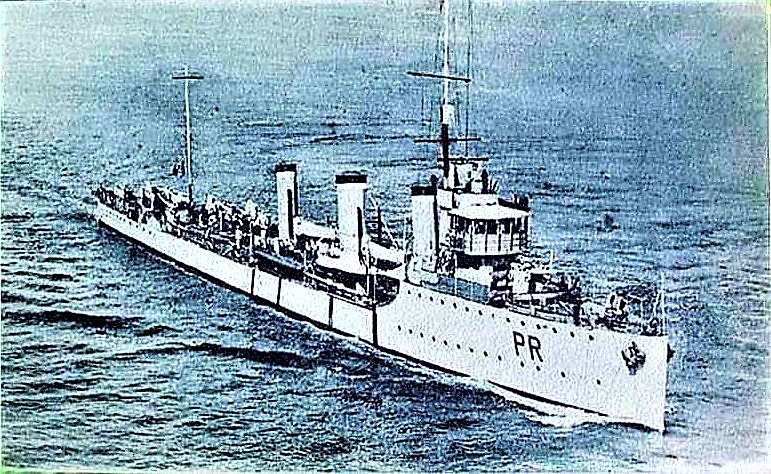
The previous Prestinari (colorized)
The general design was inspired by standard Italian destroyers, with their silhouette mixing a long forecastle, rounded bridge, and single funnel although with much lighter armament, two or three 100 mm instead of 120 mm guns (4 in instead of 4.7 in), and 18-in torpedo tubes, twice light than the 21-in used on destroyers, and in single or twin banks like WWI vessels.
The space gained was used by a long platform after of the forrecastle, supporting a generous AA armament for their escorting role. Speed was at first on part with destroyers, but went back on later classes, again to correspond to an escorting role. Their hulls had a same ratio as destroyers, 1/10, to make the best of their powerplant as well.
They had however limited ASW capabilities and even AA was not up to standards as mixing obsolete 12.7 mm and 20 mm formed only a short range defence, Italy lacked a true intermediate heavy AA between the 37 mm, absent from these TBs and 100 mm AAs. They did not have radars, unlike later Kriegsmarine torpedo boats. Range was half that of Maestrale class destroyers for example, but that was expected dfue to their missions. They were not expected to take part in fleet action, but to free destroyers of more tedious medium-range escort and patrol missions.
They had however limited ASW capabilities and even AA was not up to standards as mixing obsolete 12.7 mm and 20 mm formed only a short range defence, Italy lacked a true intermediate heavy AA between the 37 mm, absent from these TBs and 100 mm AAs. They did not have radars, unlike later Kriegsmarine torpedo boats. Range was half that of Maestrale class destroyers for example, but that was expected dfue to their missions. They were not expected to take part in fleet action, but to free destroyers of more tedious medium-range escort and patrol missions.
Two types of different “models” were created before the war. The Spica were fast, offensive TBs, while the Pegaso were heavier, larger specialized escort vessels, slower but with greater range, but still with turbines engines. The wartime classes followed these models with respectively the Ariete and Ciclone classes.
General construction and powerplant
As said above, Italian TBs’s general appearance was close to destroyers, albeit much smaller. Unlike older early 1920s vessels reclassed as TBs before the war, like the Generali, Curtatone and Palestro classes, they had a longer forecastle with more flare, a clipper bow, clipper stern, a single funnel, large bridge to house better telemetric systems, better communication suite, C-in-C features, and more deck space to accomodate AA, amost inexistant but one or two 75mm AA guns in previous vessels.
It was believed they were so light and shallow-draft that extra compartimentation of the hull below the waterline or ASW bulkheading was a waste of more useful space. However they carried still extra compartments filled with oil, acting as buffers in case of a torpedo hit. Nevertheless, without any sot of protection, they were vulnerable. A single medium to heavy caliber shell, an aerial bomb or a standard (21 in, 533mm) would have severe, practically always fatal consequences.
Powerplant wise, the first in the serie, the “prototype” albatros, common to the TBs and Gabbiano class escorts, was a specialized large submarine hunter. It had turbines but yet was still limited to 24.5 knots as a superior speed would have been a waste to hunt down submersibles of the time, capped to 18-20 kts surfaced. Endurance was good for such small vessels, at 390 tonnes standard, 1420 nm. Armament and AA was close top that of torpedo boats, albeit without torpedoes. But they were specialized ASW vessels, with a dedicated sonar, depth charge racks and launchers.
The Spica class comprised compartimented engine rooms, with two propellers shafts, drove by two Belluzo steam turbines fed by their own single admiralty boiler. In total they were rated for 19,000 hp (14,200 kW), which for a tonnage of 795 tonnes standard, gave them excellent performances at 34 knots (39 mph; 63 km/h), in fact, the best of all italian WW2 torpedo boats. The doctrine evolved for more radius of action for the next classes, but there was a returned to the Spica philosophy in late 1942 with the Ariete. They were slightly lighter, more powerful with 22,000 hp (16,400 kW) and yet, capped to 31.5 knots (36.2 mph; 58.3 km/h), but for a greater range: They carried 210 versus 207 tonnes of oil at normal load. That was consider worth the loss of three knots, giving them more versatility.
For the Pegaso and wartime Ciclone however the design was completely different. These much larger vessels (840 and 910 tonnes standard respectively) were designed more as escorts, and emphasis was on range, less than speed, which was just enough to hunt down submarines. The Pegaso class were given geared Tosi turbine engines, buy smaller and capped in order to reach 27 knots as compared to the 34 knots of the Spica. They traded this for range, 5,100 nmi (9,400 km) at 12 kn (14 mph; 22 km/h), better than destroyers and several fold that of the Spicas whicj looked lie coastal vessels in nature. This range game them abilities to criss-cross the Mediterranean and escort any convoy to any point and back without refuelling, with a margin of safety to rush at full speed on any targets.
In early 1941, the damage done by British submarines was already quite obvious, and the Pegaso model was adopted for an even larger production. The Ciclone class had Yarrow type boilers instead of the ammiraglio 3-drum models of the previous Pegaso, but still enough to be rated as the same 16,000 hp (11,900 kW), but top speed capped to 26 knots (48 km/h; 30 mph). They were slightly larger, which perhaps explained the loss in speed, but also carried less oil, 442 tons at normal load versus 520 tons, and so had a more limited range.
Armament of Italian torpedo boats

Main aft battery, TB Ariel, Spica class.
This topic is quite wide, as their armament was diverse, owing to the numerous types in service in WW2, between the “tre pipe” of WWI, the early 1920s “due pipe”, and the 1930s models, which had to have good AA and ASW armament or even carrying mines, athough that capability was not exploited.
Italian Torpedo Boats Main guns:
- Cannone da 102/35 Modello 1914: Audace, Indomito, Pilo, Sirtori/La Masa class.
- Cannone da 102 mm/45 Modello 1917/1919: Generali, Curtatone, Palestro class*.
- Cannone da 100 mm/47 Modello 1931: Gabbiano, Spica, Pegaso**
- Cannone da 100 mm/47 Modello 1937: Ciclone, Ariete***
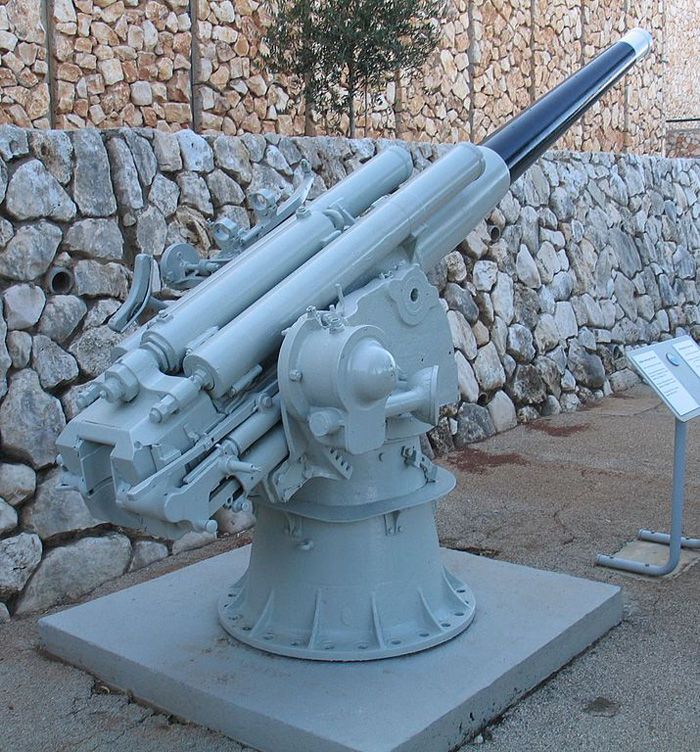
Italian 102mm/35
*Actually these were either derived from the Schneider-Arsmtrong model or the Canet Model. They fired AP: 35.3 lbs. (16 kg) or HE: 30.3 lbs. (13.74 kg) shells at 2,789 fps (850 mps), up to 16,400 yards (15,000 m) at 35° for those which modified mounting. In 1936, some received an AA mounting enabling 84°.
**Unlike WWI models, they came with a dedicated shield. Manufactured by OTO, desgigned from from 1928, they were Well-liked, but used in mountings with low maximum elevations (45°). 196.3 in (4.985 m) long and 6.2 tons, they fired a 31.3 lbs. (14.2 kg) HE shell at 2,805 fps (855 mps), 8-10 rounds per minute 1 and 16,840 yards (15,400 m).
***The OTO modello 1937 was just improved, with a 60 degrees elevation. It weighted 6.7 tons but had the same general characteristic. These were all manually operated.
The RM 1937 was used on Animoso only. Muzzle velocity was originally 2,953 fps (900 mps) but reduced in an effort to reduce dispersion. Storage varied, but it is only known for the Gabbiano class, which carried 200 rounds + 60 starshells.
Torpedoes:
Apart early captured Schichau and Whitehead models and derived units, all were built by Silurificio Italiano S.rl.
- 450 mm (17.7 in) modello torpedo for the Audace/Pilo, presumably same 17.7-in model as introduced on the 1905 Sirio class and shared by the PN class.
- Modello 140/450 for the Generali/Palestro/Curtatone classes: 29-32 knots on the 6,000-4,000 m settings and had a 1140 Kgs TNT warhead of 140 kg of TNT, and air tank loaded to 170 atmospheres.
- 45 cm (17.7″) Si 200/450 x 5.36: Interwar Italian TBs.
- 45 cm (17.7″) w 200/450 x 5.25: WW2 Italian TBs.
45 cm 200/450 Precise specs:
These were shared by torpedinieri and MAS boats 2,050 lbs. (930 kg), 17 ft. 7 in. (5.750 m) long, explosive Charge 441 lbs (200 kg), single setting 2,200 yards (2,000 m)/44 knots, powered by Wet-heater. The later W 200/450 x 5.25 was lighter at 1,896 lbs. (860 kg) and shorter 17 ft. 2.5 in. (5.250 m), same warhead by much greater range at 4,400 yards (4,000 m)/46 knots. Likely to be introduced on the Ciclone/Ariete classes during WW2.
Italian Torpedo Boats AA:
- Cannone da 76/40 Modello 1916: Standard dual purpose still onboard WWI former DDs when no replaced in WW2*.
- Ansaldo 40mm/39 AA: Derived from the British 2-pdr Pompom. In service in some modernized 1920s vessels and Spica sub-group.
- Breda 20 mm/65 Modello 1935/39: Modernized Spica and Pegaso**
- Breda 20 mm/65 Modello 1940: Ariete class**
- Scotti-Isotta Fraschini. 20 mm/70: Swiss model, only used on the Ciclone class in twin mounts***.
- Breda 13.2mm Modello 1931 HMG: Introduced on the Curtatone/Palesto class, and following interwar and WW2 TBs***.
*The 76/40 had a muzzle velocity of 680 m/s (2,200 ft/s), effective firing range of 10.7 km (6.6 mi) at +40°, max 5.8 km (19,000 ft) and 4.8 km (16,000 ft) AA.
**The 20/65 was basically a scaled up 13.2 mm (0.52″) M1931. It fired a 0.295 lbs. (0.134 kg) round at 2,756 fps (840 mps), 120-240 max rpm, to 2,500 m over surface, 2,900 m ceiling, and differed by their mounts, the M1935 dual mount was stabilized and elevated to 100°, while the single M1935 elevated to 90° only. The M1940 was a single mount with 100° elevation.
***The 20/70 was a copy of the Swiss Oerlikon, so same basic performances and carateristics.
****The 13.2mm/75.7 M1931 was derived froml the WWI Hotchkiss HMG also copied by the Japanese; It used a 13.2×99mm 51g Hotchkiss round. It fired at 85°, 400 rpm cyclic, 250 sustained, to 805 m/s (2,640 ft/s) mz, 2 km (1.2 mi) at +45°, to 3.98 km (13,100 ft) range at +80° and max 6 km (3.7 mi) at +45° or 4.2 km (14,000 ft) ceiling at +80°. Manually operated, each had a gunner and two loaders using 30 rds box mag.
Italian Torpedo Boats ASW:
- DCT (Thrower) for 100 kg (220 lbs.) model (all vessels)
- DCR (Rack) “Gatteschi” type multi-level with 2-4 DC. Only Gabbiano class Corvettes.
- Depth Charge B TG Monc. 50/1917: WWI vessels
- Depth Charge B TG Monc. 50/100 1927 4 Reg. Modernized WWI vessels.
- Depth Charge B TG Monc. 50/1936: Spica and following.*
*The B TG Monc. 50/1936 were 141 lbs. (64 kg) heavy with an explosive Charge of 110 lbs. (50 kg), sink rate or settings are unknown.
It should be added, that they all also carried paravanes which were noted at the time as “siluro trainato” (towed torpedoes).
Swedish Exports: Romulus class

HMS Romulus
The first two vessels of the Spica class (Astore, Spica of their own group), which acted a bit as prototypes, were exported to Sweden in 1940. They were renamed Romulus and Remus in hommage to their Italian origins and myhical founding figures of Rome. HSwMS Romulus was in service during World War II, and first decades of the Cold War, stricken in 1958. HSwMS Remus also patroled Swedish waters during WW2 and was stricken in 1958, scrapped in 1961.
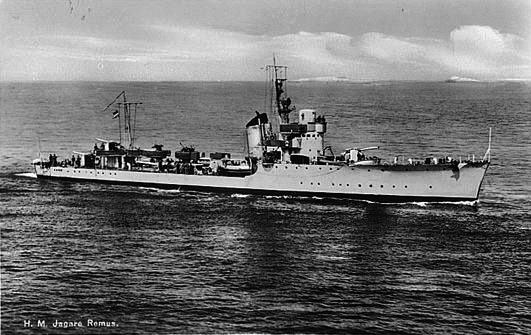
HMS Remus
Italian Torpedo Boats at war 1940-43
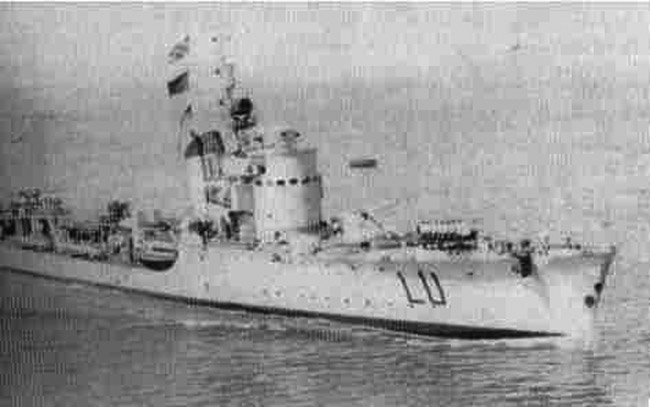
Lupo in 1942
It’s difficult to really summup Torpedo Boats actions in WW2, or tactics. The latter differed in large part due to their types: Both the Spica and Ariete were used for medium-range defence, and escort. The Pegaso/Ciclone were mosetly used solely for escort, both for convoy protection and ASW warfare, patrolling alone or in small squadrons.
In case of destroyers attacks, they were likely able to somewhat defend the convoy by making a torpedo barrage, and lay smoke. Due to their age and speed, the older Generali class and other “tre pipe” as well as the Curtatone/Palestro were mostly used for escort duties only. This did not excluse more agressive stances, like at the battle of Vado, where Calatafimi attacked the French Cruisers engaged in a bombing raid of the coast. She was detached while in escort of a minelayer approaching to secure the approaches of Genoa, when spotting the French attack. Italian propaganda later glorified this attack, but no French vessel was sunk that day.
Losses were appealing: From 1940 to 1945, first under Italian flags, and second under German flag from 1944, 48 of the interwar and WW2 vessels were sunk, and 29 of the WWI and early interwar classes, so about 3/4 of their entire numbers. They were sunk by torpedo and gunfire as well by air attacks, but about a dozen were scuttled and two were sunk by mines (Aldebaran and Altair).
An overview of their combat records
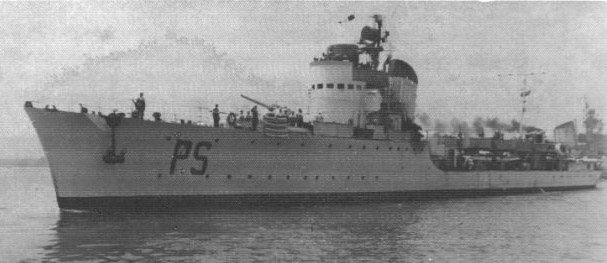
Perseo underway
Combat records are a good way to approach the detailed operations of these vessels. They were certainly successful for some, depending of opportunities, shooting down about 30-35 planes including the very fast Beaufighter. Some sunk upt to four British submarines, proving they were among their greatest threat. Altogether they sank perhaps 15 subs.
They rarely won contests over destroyers, but some inflicted quite severe damage to them. The average British DD could survive a 45 cm torpedo hit. Their speed was certainly a saving grace, as some went unscaved from very intense battles opposing cruisers and destroyers. We must remember they were rarely used for anything else than convoy escort duties, giving them little chances to shine; But at more than one occasions they saved the sole of several cargoes they escorted.
Camouflage and concealement
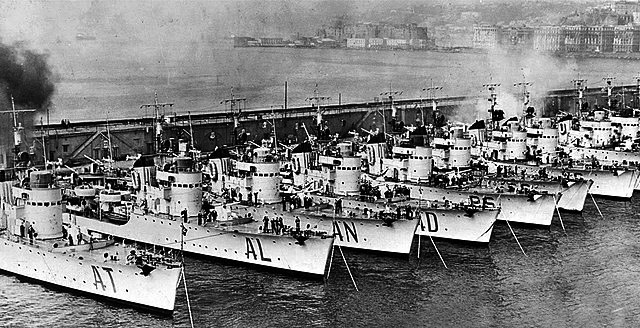
Altair, Aldebaran, Antares, Andromeda, Perseo, Sagittario and Vega in port showing their ID letters (Coll. Giorgio Parodi)
First off, Italian TBs were smaller than destroyers (although they could be confounded by them due to their similar silhouette, at least for interwar and WW2 vessels). This could play a deterrent effect for assailants, and was probably intended. Speed was one advantage, a lightweight hulls and agility, but active concealement was mostly due to the use of smoke dischargers. The Italian Cruisers and destroyers were all fitted with these, and smoke laying was practiced and well understood in combat. It could be a way to conceal a convoy for torpeod boats. However there are no precise information available on Torpedinieri own smokelaying devices or system, nor tactics or defines use.
For identification, after the Battle of Calabria of July 1940 where there was a serious friendly fire, Italian TBs, like all other Italian ships, received on their quartedecks, bow and stern sometimes, a simple red and white stripes pattern. These were used until the Italians capitlated to avoid friendly bombing from the aviation. Some even had their stern deck also painted this way and ship-borne seaplanes also had their upper or main wings painted also that way.
Torpedo Boats decks were left in part metal with metallic traces (Grigio Ferro) and wood. The hull underwater was brick red (Rosso Mattone) with waterline black lines.
For horizontal surfaces, they kept their leggero grigio or “grigio cenerino chiaro” overall prewar matte paint, with identification letters related to their second name, first and last letters. Ex. CT for “Curtatone”, PG for “Pegaso”, VG for “Vega”, etc.
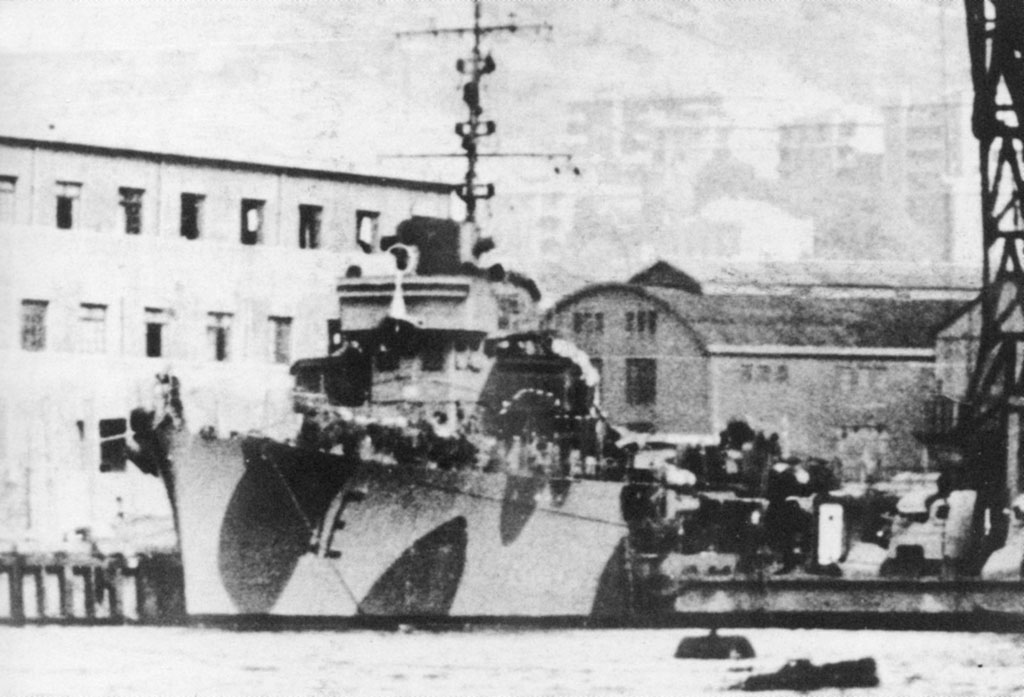
Ariete in Genoa, 23 August 1943, showing her unusual rounded camouflage shapes.
As for passive concealement, In WW2 it became common practice to camouflage torpedo boats, but it was not systematic. But as WW2 progressed, they received a regulated camouflage, applied also to destroyers: Simple dark grey (“grigio scuro”) with hard edges shapes over their original light grey. Light blue (“Azzurro”) or Light ash grey (“Grigio Cenerino”) were rarely seen. However to deceit submarines about their real lenght, either fake bow waves or more commonly white areas at the bow and stern were painted in “bianco”. ID letters were painted in black or red depending of the camouflage pattern. After Italy joined the allies, the few remaining TBs were painted like allied vessels, with a dark hull and light grey superstructures. The ID was painted in black.
Cold War Fate
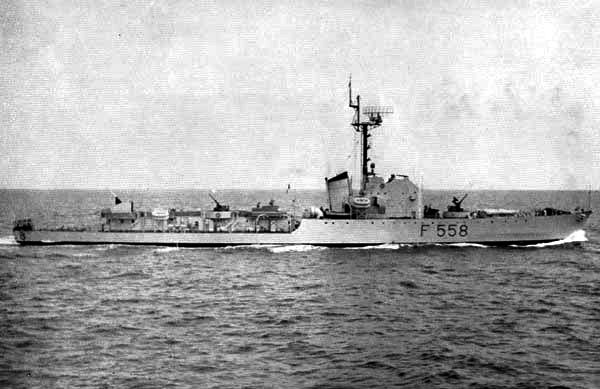
Orsa (F-558) as rebuilt in the 1950s
Only a few Torpediniere remained after WW2: Seven of the Spica-class, two of the Pegaso class (Orione and Orsa). The rest, three Ciclone class went as war prize to to USSR and two to Yugoslavia, and three more of the Ariete clas to Yugoslavia in 1948-49. They mostly provided a “stopgap service” of a few years. The Yugoslavian ships were known as the Biokovo, Triglav, Ucka, Durmitor, Valebit (ex. Ta-46, never completed and BU).
The Italian vessels were all reclassified as covettes in 1950, and it was envisioned their modernization and possible reconstruction. Some were even older than that: There were still surviving WW1-vintage Pilo, La Masa, and Curtatone class vessels, of which three Pilo became minesweepers after refit in 1953 (Abba and Mosto) and discarded in 1958. Carini and Fabrizi (La Masa class) were converted the same way, discarded in 1957-58. The sole Curtatone was scrapped without modifications in 1957.
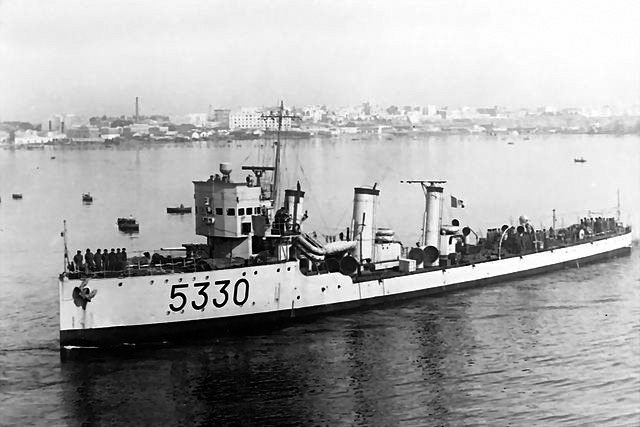
The minesweeper Abba (M5330) in the 1950s, certainly among the oldest NATO vessels still in activity.
Interwar TBs of the Spica class became fast ASW corvettes and their modernization took place in 1952. Their torpedo tubes were all removed, a single 100 mm was removed, but an ASW Hedgehog was added in its place, whereas the Bridge was modified and a radar added, along with a new NATO standard sonar. In 1958 they also gained two 40mm AA.
-Sagittario was used to test various types of weaponry, and in 1958 for all survving ship the remainder 100mm/47 was removed.
-The same modifications were applied to the Pegaso-class Orione and Orsa. These were discarded in 1959-64.
Italian Interwar Torpedo Boats
 Albatros (1934)
Albatros (1934)
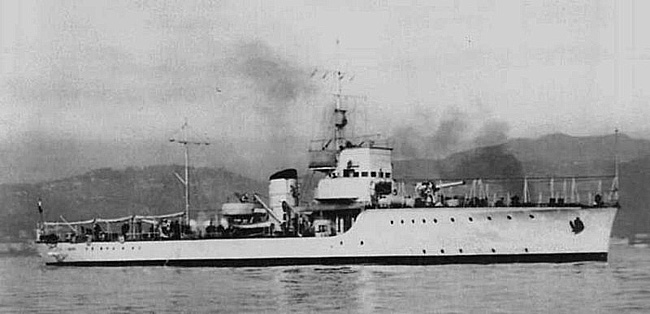
Albatros in 1936
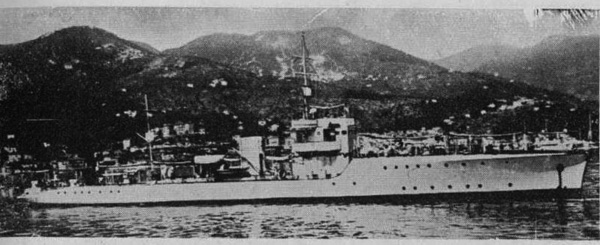
With the threat posed by submersibles in WWI, and the late response that came from the entente, Italy started to study a dedicated sub-hunter as far back as the late 1920s. These ended with a design, the Albatros, the first experimental project proposed to thje admiralty by CNR Palermo, which was accepted for production. The RM planning in addition had it built as the head of a 25 ships plan.
Preliminary study in 1929 retook the hull shape of contemporary foreign coastal torpedo boats, notably the forecatle, and a pair of 450 mm torpedo tubes was to be installed in her bow. Though, due to the terms of London Naval Treaty that Italy signed in 1930, there was a limited tonnage above 600t authorized, and thus, these sub-hunters had to be designed to be declared with a standard figure right nelow this tonnage. The prototype in the end was rather unsuccessful.
Albatros was laid down in November 1931 at Palermo, launched on 27 May 1934 and commissioned on 10 November 1934. Her sea trials started right away and reports were not enthusiastic. Despite her forecastle she lacked seaworthiness in open sea, was costly to operate and difficult to maintain correctly her steam propulsion turbines. Other criticized her outdated armament (two WWI 100mm/47 notably, no sonar or hydrophones, for her primary task). Eventually, the project was canceled and work shifted towards the larger Pegaso class escorts while torpedo tubes were never installed. In 1935, Albatros was reclassified as a second-line ship, assigned to Regia Marina’s naval experimental unit at La Spezia, a nice way to say she was no longer operational. And in 1938 she was reclassified as a “torpedo boat”, despite she had no torpedo tube…
She had a SAFAR 600 sonar installed in June 1939, and in 1940 she received extra AA. She was used to patrol the Strait of Messina, and along the eastern coast of Sicily. In all she performed 57 missions, betwen escort and submarine patrols. In 1940 in June-July she was attacked twice by British submarines, and on September 27, 1941 she was to meet U-371 to escort her through the Strait of Messina. However HMS Upright (the strtait was a British captains’s favorite ambush position) spotted Albatros off Milazzo.
Albatros detected the submarine practically at the same time and closed at full speed for a first DC pass, trying to ping her position. At 8:55, she came for a second pass, when Upright launched two torpedoes from 2,750 meters away, one hitting Albatros, sinking 8 miles (12.8 km) NW of Milazzo, with 47 survivors.
⚙ Albatros specifications 1939 |
|
| Dimensions | 70.56 x 6.9 x 1.71-2.25 m (231.5 x 22.5 x 5ft 7in-7ft 5in) |
| Displacement | 334 tons standard, 490 tons Fully Loaded |
| Crew | 52 wartime |
| Propulsion | 2 shafts Belluzo turbines, 2 3-drum boilers, 4,300 shp. |
| Speed | 24.5 knots ( km/h) |
| Range | 1,420 nm @ 10 knots. |
| Armament | 2× 100mm/35, 2x 13.2 mm, 2x 8mm AA, 4 DCT, 2 DCR, 2 Paravanes |
 Spica class (1933)
Spica class (1933)
Airone, Alcione, Aldebaran, Altair, Andromeda, Antares, Aretusa, Ariel, Astore, Calipso, Calliope, Canopo, Cassiopea, Castore, Centauro, Cigno, Circe, Climene, Clio, Libra, Lince, Lira, Lupo, Pallade, Partenope, Perseo, Pleiadi, Polluce, Sagittario, Sirio, Spica, Vega
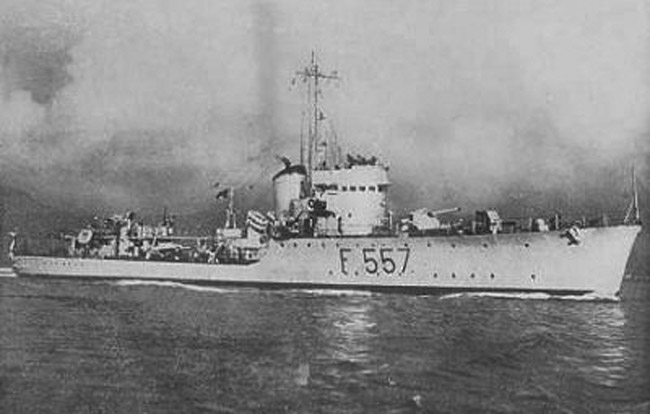
Design
First interwar Italian TB design. They were 75 m long at the waterline, 80.4-82 m long (273 feets) for 620-670 tons standard and 885-1,030 long tons (1,040 t) full load, so already above the London limits. Mussolini followed Germany and Italy in refusing these limits. By comparison the German Type 1935 TBs were 844 tonnes standard, but they were laid down much later in 1937. These were generally handsome vessels resembling miniature Freccias. Their value as escort vessles was discovered during the war.
Their tonnage diverged in between groups, The Spica group was sold to Sweden, leaving the Climene group (Canopo, Cassiopeia, Castore, Centauro, Cigno, Climene) with 640 tonnes standard, the Perso Group (Aldebaran, Altair, Andomeda, Antares, Perseo, Sagittario, Sirio, Vega) were 630/985 tons, and the Alcione Group (the remainder) were 670/1,030 tons. Their machinery was arranged into three compartments, two boilers rooms, one single engine room. At 15 kts their endurance was still 1800 nm. 34 knots was nominal as they reached on trials speeds in excess of 37 kts. But with wartime addition up to 250 extra tons were added and with wear and tear they generally were limited to 30 kts max and 26 kts in operations in 1940-43.
Spica general rendition (ONI)
They way their carried their torpedoes also changed between classes: The Spica, Climene, centauro series had a single tube on each beam, and twin on the centerline. Later with the remainder Climene group and Perso plus the CNQ built vessels, they had two twin tubes nbanks centerline, more destroyer-like. This was also for stability. In fact in 1939-41 all vessels were converted to this arrangement. AA varied also, as the two original Spica and Astore were completed with two twin 40 mm/39 AA guns and four 13.2 mm, but the rest has all eight in all, in single and twin mounts. In WW2, they were replaced when possible by commion Breda 20mm/65 mountings and the standard became three twin of them, plus a twin 13.2 mm, and in 1941-42, extra DC throwers were added, with 40 in stowage. They were equipped for monelaying and could carry 18-20 mines but this
However for this, their ASW capabilities were fairly limited. Adding these would have compromise their stability because of the topweight, and the admilty never consented to sacrifice torpedo tubes. They became however moderately good AS vessels and their AA was reinforced during WW2. In all, 7 were lost in surface actions, 8 by aviation, 3 by mines and 3 by submarines. They gave Italy an edge over France in 1940 as these numerous TBs were cheap and could replace advantageously destroyers in some ways.
The Spica class torpedo boats in Combat
Airone was sunk on 12 October 1940 at the battle of Cape Passero by HMS Ajax. She scored three hits before being disabled and 59 went down with her. Ajax’s bridge and radar installations were damaged by the TB, with 13 killed and 26 wounded. Alcione was torpedoed on 11 December 1941 by submarine HMS Truant. Aldebaran was sunk on 20 October 1941 in the Saronic Gulf by mines laid by HMS Rorqual. Altair had the same fate, same day. Andromeda was sunk on 17 March 1941 at Valona in Albania by RAF bombers. Antares sank the Greek submarine Proteus by ramming on 29 December 1940 and was herself sunk on 28 March 1943 at Livorno by USAAF bombers.
Aretusa on 2 December 1942 escort, shot down a Fairey Albacore south of Kerkennah Islands while Lupo was sunk by British destroyers. She was badamy damaged in a airstrike on 13 April 1943 but survived the war (discarded 1958). Ariel was sunk 12 October 1940 by HMS Ajax like Airone.
Calipso was sunk on 5 December 1940 by mines east of Tripoli. Calliope provided 117 convoys escort missions, 21 various combat missions over 77,500 miles, shooting down six British aircraft and survived the war. Canopo was sunk on 3 May 1941 by British bombers in Tripoli. Cassiopea managed to sink the British destroyer HMS Pakenham in battle southeast of Marettimo island (16 April 1943) but she was heavily damaged to be towed by Climene to safety and survived the war. Castore led a convoy from Tripoli to Taranto, managing to escape an attack from the destroyers HMS Jaguar, Lance, Lively and Zulu, already attacked by Swordfish of the 830 Sqn. Later she also repelled British motor boats off Tobruk (Operation Agreement). She was sunk on 2 June 1943 by HMS Jervis and Vasilissa Olga defending her convoy (and saving it).
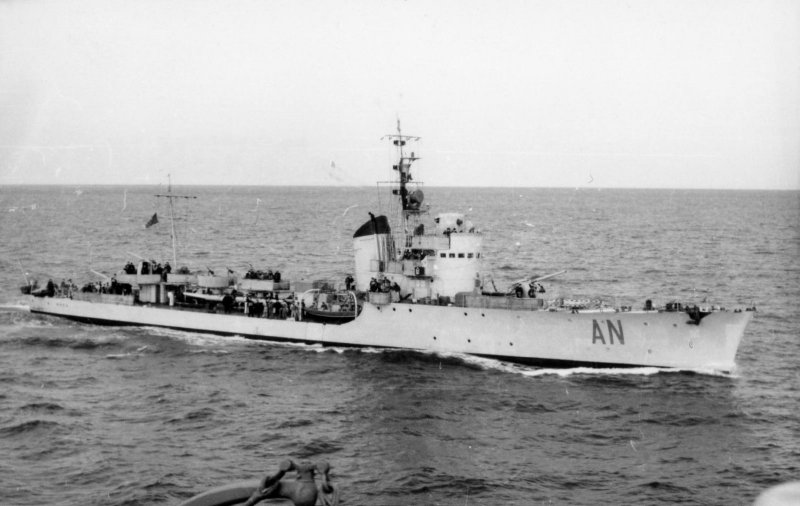
Antares of the Spica class
Centauro was sunk on 4 November 1942 in Benghazi harbour. Cigno protected a four-freighter convoy to Tripoli on 26 May 1941 shooting down to Blenheim bombers, recuting survovors after the Battle of Cape Bon, and dodged four torpedoes from HNLMS Isaac Sweers. She was sunk in battle 16 April 1943 southeast of Marettimo island by HMS Paladin and HMS Pakenham. Circe attempted to ambush a British convoy south of Pantelleria in January 1941. She duelled with HMS Bonaventure but was damaged. She also managed to sink the submarines HMS Grampus, HMS Union, HMS P38 and HMS Tempest but was sunk in a collision on 27 November 1942.
Climene on 24 April 1936 took part in the shooting down of three Beaufort bombers and a Beaufighter on 20–21 August 1942 and was torpedoed on 28 April 1943 by HMS Unshaken. Clio sank the submarine HMS Triton in December 1940, and shot down a Swordfish from HMS Illustrious off Sfax on 21 December 1940. She took part in the battle of Skerki Bank on 2 December 1942 and survived the war. Libra with Lupo attacked by night the convoy AN 14 on 31 January 1941 and survived the war, only decomm. in 1964. Lince landed troops at Kastelorizo in February 1941. She was torpedoed and grounded on 28 August 1943 by HMS Ultor. Lira was scuttled 9 September 1943, and as TA49, sunk by bombing 4 November 1944.
Lupo with Libra attacjed a convoy and badaly damaged the British tanker Desmoulea (8120 tn) in the Kasos straits (31 January 1941). Under Captain Francesco Mimbelli she took part in the reconquest of Kastelorizo and Battle of Crete. She was sunk 2 December 1942 by HMS Jervis, Javelin, Janus and Kelvin. Pallade was sunk 5 August 1942 by air attack in Naples. Partenope shot down two Blenheim on 11 July 1941 and hit a mine off Preveza on 26 July 1943, scuttled while on drydock at Naples. Perseo was sunk on 4 May 1943 off Cape Bon by HMS Nubian, HMS Petard and HMS Paladin. Pleiadi was wrecked on 31 May 1941 off Tripoli after a fire onboard and finished off during an airstrike on 14 October 1941 while refloated.
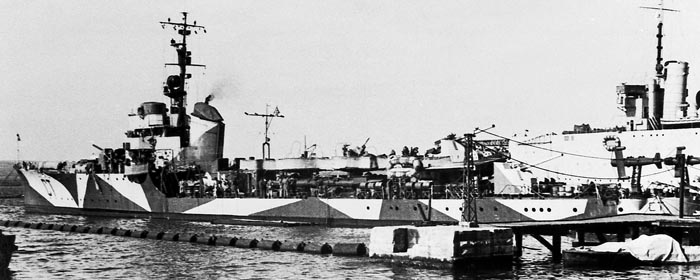
Castore in 1942
Polluce sank the submarine HMS Grampus in June 1940 with Circe, Clio and Calliope but was lost to torpedo bombers on 4 September 1942. Sagittario successfully protected a German convoy during the Battle of Crete and badmy damaged HMS Kingston as destroyed MTB 639 off Tunis, on 28 April 1943. Survived the war until 1964. Sirio started the battle of Cape Spartivento, being spotted first. On 16 February 1943, during a convoy escort she fought off MTB 77, MTB 82 and MTB 62 south of Marettimo. Survived the war until 1959. Vega Shot down a Swordfish from HMS Illustrious off Sfax on 21 December 1940. She was sunk by HMS Hereward 10 January 1941 in the strait of Sicily.

Cutaway of the Spica class
Cutaway of the class, De Agostini coll.
⚙ Spica specifications 1939 |
|
| Dimensions | 80-82 x 8.20 (Alcione Gpe 7.92m) x 2.82-3.09 m (264-269 x 26 x 9 ft) |
| Displacement | 620-670 tons standard, 885-1,030 tons Fully Loaded |
| Crew | 99 peacetime – 120 wartime |
| Propulsion | 2 shafts Tosi turbines, 2 Yarrow boilers, 19,000 shp. |
| Speed | 34 knots ( km/h) |
| Range | 207 tons oil, 1,800 nm @ 15 knots. |
| Armament | 3× 100/47, 4x 450 m TTs, 8x 13.2 mm, 2 DCT, 2 Paravanes |
 Pegaso/Orsa class (1936)
Pegaso/Orsa class (1936)
Pegaso, Procione, Orione, Orsa
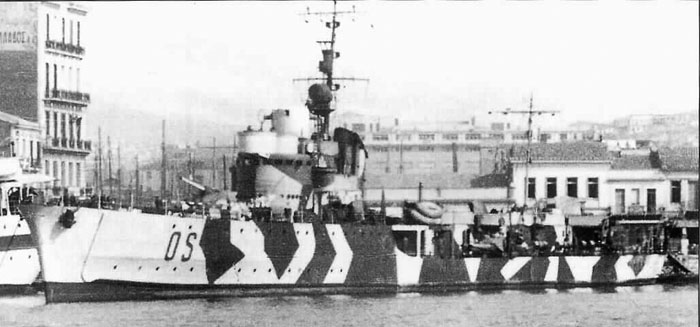
Orsa in port, 1942 with her quirky camouflage
The Orsa class (Or Pegaso for Conways) were large mixed torpedo boats/destroyer escorts designed as a enlarged version of the Spica-class but with less speed, more endurance and greater ASW armament, and lighter gun armament (two instead of three main guns). They were originally designed in 1935 and re-rated from escort ships to “escort torpedo boats” in 1938. They also carried still two pairs of TTs on the broadside, but still lacked an effective AA armament. Sea speed was rerated at 27 kts in operation. The “P” were built at BSN and the two “O” at CNR Palermo yards. During the war theu replacd their 13.2 mm by 8-11 20mm/65 Breda guns.
Pegaso sank the British submarines HMS Upholder, HMS Undaunted, and HMS Thorn. She was attacked while escorting a convoy to Tripoli on 26 May 1941 by Blenheim bombers, shooting down two. She downed a Beaufort bomber and Beaufighter on 21 August 1942 ending as one one of the most successful Axis anti-submarine warships of World War II, being scuttled 11 September 1943 at Majorca. Orsa along with the Spica-class Climene shot down three attacking British aircraft on 24 July 1942 while escorting Vettor Pisani. She survived until 1964 . The first two were scuttled in September at Majorca and La Spezia respectively. The others served long after the war as AS Frigates, reconstructed.

Orsa blueprint
⚙ Pegaso class specifications 1939 |
|
| Dimensions | 82.5 x 9.69 x 3.74 m (270 ft 8 in x 31 ft 9 in x 12ft 3in) |
| Displacement | 840 tons standard, 1,575 tons Fully Loaded |
| Crew | 116 |
| Propulsion | 2 shafts turbines, 2 boilers, 16,000 shp (11,900 kw). |
| Speed | 28 knots (32 km/h) |
| Range | 520 tons oil, 5,000 nm @ 14 knots. |
| Armament | 2× 100/47, 4×2 13.2 mm, 6 DCT, 2 Paravanes |
Italian WW2 Torpedo Boats
 Ciclone class (1942)
Ciclone class (1942)
Aliseo, Animoso, Ardente, Ardimentoso, Ardito, Ciclone, Fortunale, Ghibli, Impavido, Impetouso, Indomito, Intrepido, Monsone, Tifone, Uragano
Design of the Ciclone class
The Ciclone class laid down in 1941 were slightly enlarged versions of the previous Orsa/Pegaso class but with better stability and better ASW capabilities, as part of the war mobilization programme. Completed in 1942–43 most saw action under the Regia Marina flag. All were fitted with a sonar and two twin broadside torpedo launchers. They however differed in armament, with Ghibli, Impavido, Impetuoso, Indomito, Monsone given three single 100/47mm guns, and four twin 20mm/65mm AA guns, while Aliseo, Ardente, Ciclone, Fortunale, Groppo, Tifone, Uragano had a two 100/47mm guns plus the third ordiginal gun replaced by an additional twin 20/65mm for ten total. Animoso, Ardito, Ardimentoso, Intrepido had two main guns, and central mounting with a quadruple 20/65mm mounting, for 12 total. They were the most heavily armed of all Italian TBs in WW2.

Ciclone
The Ciclone class in action
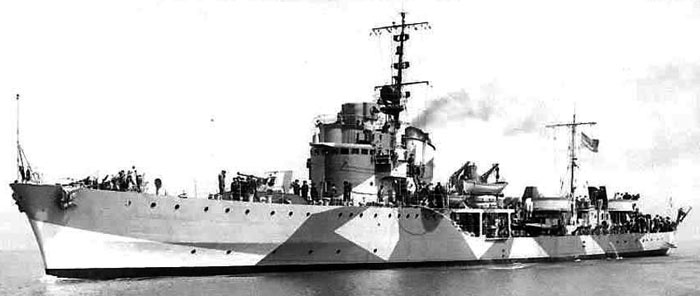
Ciclone in 1942
Aliseo engaged and destroyed German auxiliary vessels off Bastia after the Cassibile armistice and became in 1949 the Yugoslav Triglav. Animoso ended as war reparation to the USSR in 1949 as Ladny. Ardente sank the submarine HMS P48 on 25 December 1942 and collded with the destroyer Grecale on 12 January 1943, never repaired. Ardimentoso became a war reparation to USSR as Liuty. Ardito sank the submarine HMS Turbulent on 6 March 1943 and took part in the battle of off Bastia with Aliseo. Captured by the Germans in September 1943 as TA26. Her fate is uncertain. Ciclone shoot down three Beaufort bombers and a Beaufighter on 20-21 August 1942 but sunk on a mine on 8 March 1943.
Fortunale sank the submarine HMS P222 on 12 December 1942 and ended in USSR as Liotny. Ghibli was captured in September 1943 but scuttled in La Spezia 25 April 1945. Groppo claimed a Bristol Beaufort on 23 January 1943 and captured an RAF inflatable motor boat from a downed Lockheed Hudson bomber on 22 February. She was sunk by USAAF raid on 25 May 1943 in Messina. Impavido was captured by the Germans in September 1943 (TA23), sunk by mine on 25 April 1944 and while in two, torpedoed by MTBs. Impetouso was scuttled 11 September 1943.
Indomito became the Yugoslav Biokovo in 1949. Intrepido was captured by the Germans, TA25, sunk by US PT boats on 15 July 1944. Monsone repelled three British MTBs off Marettimo on 16 February 1943 with Sirio, Gabbiano and Antilope, located thanks to their sonar. She was Sunk on 1 March 1943 at Naples by USAAF. Tifone escorted the Cigno convoy on 16 April 1943 and delivered fuel to Bizerte. Damaged by USAAF, scuttled at Korbous, Tunisia, on 7 May 1943. Uragano was sunk by mines on 3 February 1943.

Cutaway of Ardito
⚙ Albatros specifications 1939 |
|
| Dimensions | 82.5 x 9.9 x 3.77m (270 x 32 x 12ft) |
| Displacement | 910 tons standard, 1,625 tons Fully Loaded |
| Crew | 154 |
| Propulsion | 2 shafts turbines, 2 Yarrow boilers, 16,000 shp. |
| Speed | 26 knots (48 km/h) |
| Range | 4,000 nm @ 14 knots. |
| Armament | 2-3× 100/47mm, 8-12x 20mm AA (8x 13.2 mm orig), 2×2 450mm TTs, 4 DCT, 2 paravanes |
 Ariete class (1943)
Ariete class (1943)
Ghibli, Impavido, Impetuoso, Indomito, Monsone, Aliseo, Ardente, Ciclone, Fortunale, Groppo, Tifone, Uragano, Animoso, Ardito, Ardimentoso, Intrepido
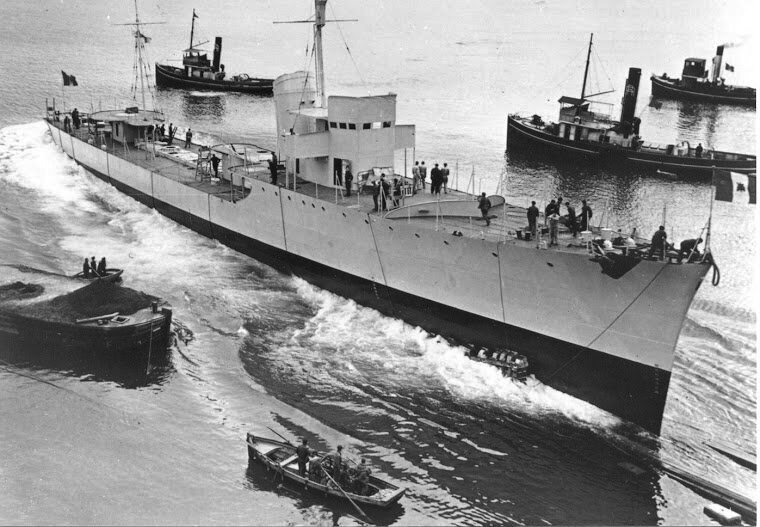
Arturo launch in 1943.
The Ariete-class, although niminal successors of the Spica class, were designed as destroyer escorts, enlarged versions of the Spica-class but really made to escort convoys to North Africa. Of the 42 planned, only sixteen were eventually ordered, just one completed when the armistice came: Ariete, built at Sestri Ponente, commissioned on 5 August 1943, also the only one to survive the war. She was ceded to the Yugoslav Navy 1949 as Durmitor.
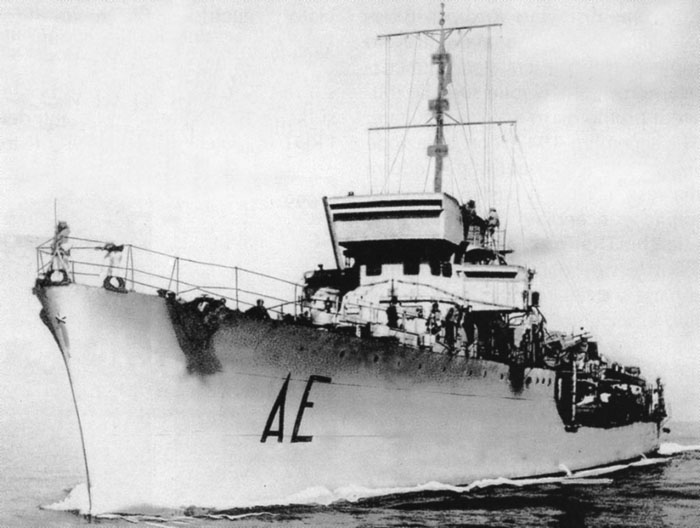
Ariete on trials in August 1943.
The others were captured on slip and completed by the Germans. Designated “TA” for “Torpedoboot Ausland” they were sunk in various operations across the Aegean and the Adriatic. Fionda (TA46) was sunk in Fiume by an air raid on 20 February 1945 with TA47, still unfinished and recovered by the Yugoslavians in 1947. Učka, the first, was decommissioned in 1971. For more, see the future (unwritted yet) German WW2 TB page.

Ariete in Genoa, 23 August 1943
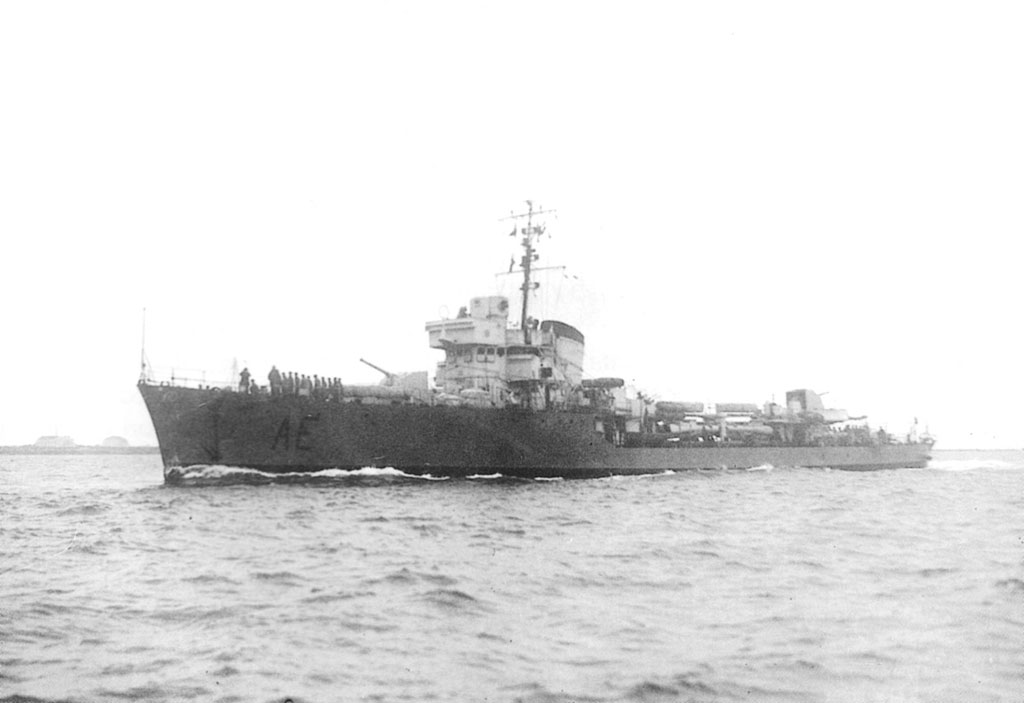
Ariete in Taranto, in non-belligerence paint, 1944
⚙ Albatros specifications 1939 |
|
| Dimensions | 70.56 x 6.9 x 1.71-2.25 m (231.5 x 22.5 x 5ft 7in-7ft 5in) |
| Displacement | 334 tons standard, 490 tons Fully Loaded |
| Crew | 52 wartime |
| Propulsion | 2 shafts Belluzo turbines, 2 3-drum boilers, 4,300 shp. |
| Speed | 24.5 knots ( km/h) |
| Range | 1,420 nm @ 10 knots. |
| Armament | 2× 100/35, 2x 13.2 mm, 2x 8mm AA, 4 DCT, 2 DCR, 2 Paravanes |
Read More, sources
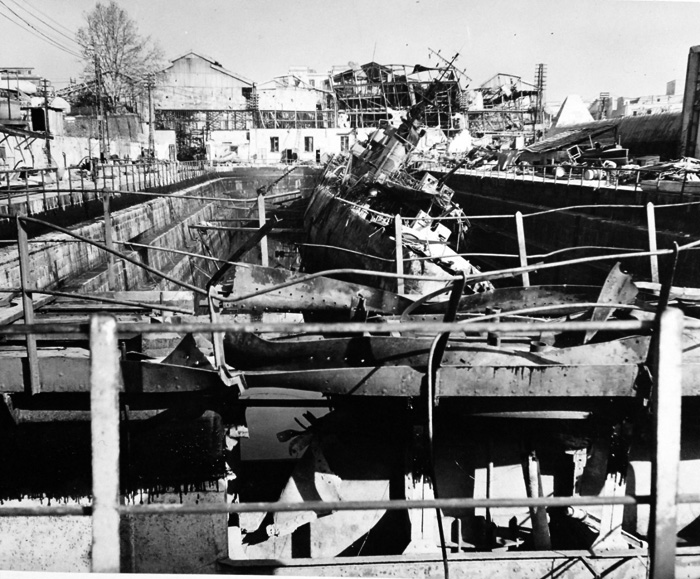
Italian TB Partenope, 1943
Links
THE EFFECTIVENESS OF THE “WASHINGTON TREATY” NAVY, naval college
curtatone * albatros * spica * spica it * ariete * pegaso * ciclone * ciclone it
Camo on worldofwarships.com
102mm/47_m1931 nawveaps
20mm/65 nawveaps
132- 757_m1931
naviearmatori.net
combattentiereduci.it
conlapelleappesaaunchiodo.blogspot.com
ilterzonano.altervista.org
ocean4future.org
naveardito.it
navymodeling.com
digilander.libero.it
culturanavale.it
ariete-class-torpedo-boats
spica-class-torpedo-boats
comandosupremo.com/spica-class-torpedo-boat
marina.difesa.it
italie1935-45.com
Italian WW1 destroyers
Books
Gardiner, Robert & Chesneau, Roger (1980). Conway’s All The World’s Fighting Ships 1922–1946.
Fraccaroli, Aldo (1985). “Italy”. In Gray, Randal (ed.). Conways AWFS 1906–1921
Gianni Rocca, Fucilate gli ammiragli. La tragedia della Marina italiana nella seconda guerra mondiale, p. 270.
A. Nobili, M.E. Palmisano, Il patrimonio ritrovato. Navi, sottomarini e aerei dei nostri fondali, Regione Siciliana, 2010.
Giorgio Giorgerini, La guerra italiana sul mare. La Marina tra vittoria e sconfitta 1940-1943, p. 543.
Ufficio Storico della M.M.
Brescia, Maurizio (2012). Mussolini’s Navy: A Reference Guide to the Regina Marina 1930–45.
Campbell, John (1985). Naval Weapons of World War Two. Naval Institute Press.
Dodson, Aidan & Cant, Serena (2020). Spoils of War: The Fate of Enemy Fleets after Two World Wars. Seaforth Publishing.
Fraccaroli, Aldo (1968). Italian Warships of World War II. Ian Allan.
Whitley, M. J. (1988). Destroyers of World War 2: An International Encyclopedia.
Videos
youtube.com/watch?v=9K2Cl5HJBYo footage of espero
youtube.com/watch?v=tYFKhPehG20 launch of Partenope
The model’s corner
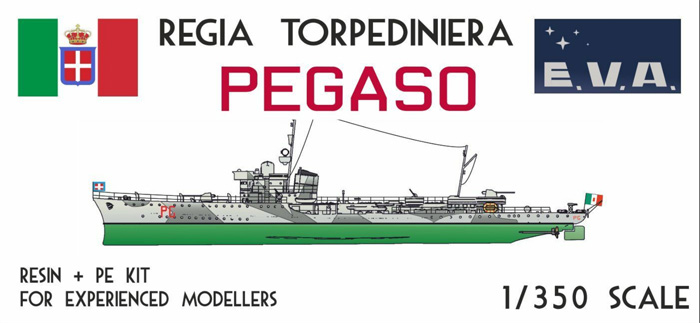
Resin 1:350 scale by EVA of the Pegaso.
Not a lot of choice, but very small ones for waregaming and in 3D print.

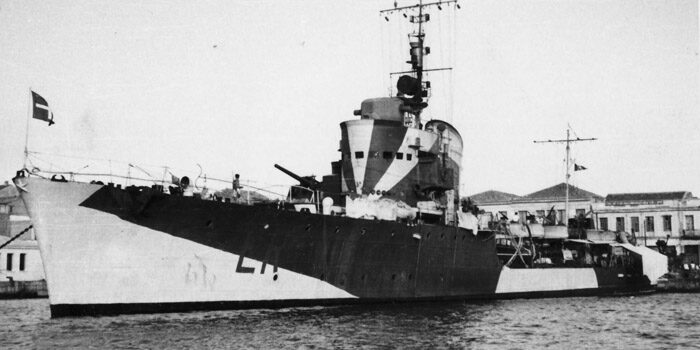

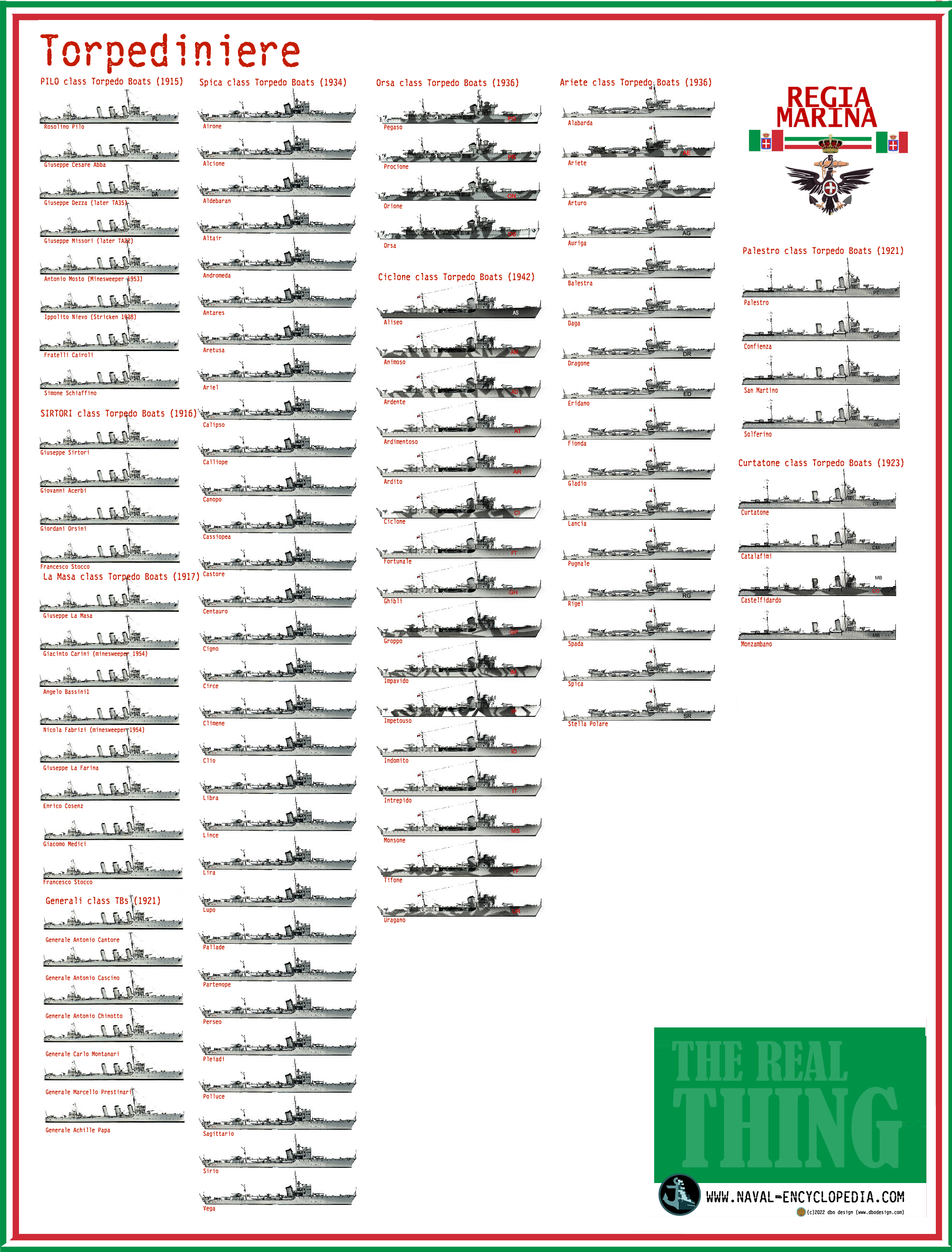

 Latest Facebook Entry -
Latest Facebook Entry -  X(Tweeter) Naval Encyclopedia's deck archive
X(Tweeter) Naval Encyclopedia's deck archive Instagram (@navalencyc)
Instagram (@navalencyc)





 French Navy
French Navy Royal Navy
Royal Navy Russian Navy
Russian Navy Armada Espanola
Armada Espanola Austrian Navy
Austrian Navy K.u.K. Kriegsmarine
K.u.K. Kriegsmarine Dansk Marine
Dansk Marine Nautiko Hellenon
Nautiko Hellenon Koninklije Marine 1870
Koninklije Marine 1870 Marinha do Brasil
Marinha do Brasil Osmanlı Donanması
Osmanlı Donanması Marina Do Peru
Marina Do Peru Marinha do Portugal
Marinha do Portugal Regia Marina 1870
Regia Marina 1870 Nihhon Kaigun 1870
Nihhon Kaigun 1870 Preußische Marine 1870
Preußische Marine 1870 Russkiy Flot 1870
Russkiy Flot 1870 Svenska marinen
Svenska marinen Søværnet
Søværnet Union Navy
Union Navy Confederate Navy
Confederate Navy Armada de Argentina
Armada de Argentina Imperial Chinese Navy
Imperial Chinese Navy Marinha do Portugal
Marinha do Portugal Mexico
Mexico Kaiserliche Marine
Kaiserliche Marine 1898 US Navy
1898 US Navy Sovietskiy Flot
Sovietskiy Flot Royal Canadian Navy
Royal Canadian Navy Royal Australian Navy
Royal Australian Navy RNZN Fleet
RNZN Fleet Chinese Navy 1937
Chinese Navy 1937 Kriegsmarine
Kriegsmarine Chilean Navy
Chilean Navy Danish Navy
Danish Navy Finnish Navy
Finnish Navy Hellenic Navy
Hellenic Navy Polish Navy
Polish Navy Romanian Navy
Romanian Navy Turkish Navy
Turkish Navy Royal Yugoslav Navy
Royal Yugoslav Navy Royal Thai Navy
Royal Thai Navy Minor Navies
Minor Navies Albania
Albania Austria
Austria Belgium
Belgium Columbia
Columbia Costa Rica
Costa Rica Cuba
Cuba Czechoslovakia
Czechoslovakia Dominican Republic
Dominican Republic Haiti
Haiti Hungary
Hungary Honduras
Honduras Estonia
Estonia Iceland
Iceland Eire
Eire Equador
Equador Iran
Iran Iraq
Iraq Latvia
Latvia Liberia
Liberia Lithuania
Lithuania Mandchukuo
Mandchukuo Morocco
Morocco Nicaragua
Nicaragua Persia
Persia San Salvador
San Salvador Sarawak
Sarawak Uruguay
Uruguay Venezuela
Venezuela Zanzibar
Zanzibar Warsaw Pact Navies
Warsaw Pact Navies Bulgaria
Bulgaria Hungary
Hungary

 Bundesmarine
Bundesmarine Dutch Navy
Dutch Navy Hellenic Navy
Hellenic Navy Marina Militare
Marina Militare Yugoslav Navy
Yugoslav Navy Chinese Navy
Chinese Navy Indian Navy
Indian Navy Indonesian Navy
Indonesian Navy JMSDF
JMSDF North Korean Navy
North Korean Navy Pakistani Navy
Pakistani Navy Philippines Navy
Philippines Navy ROKN
ROKN Rep. of Singapore Navy
Rep. of Singapore Navy Taiwanese Navy
Taiwanese Navy IDF Navy
IDF Navy Saudi Navy
Saudi Navy Royal New Zealand Navy
Royal New Zealand Navy Egyptian Navy
Egyptian Navy South African Navy
South African Navy






























 Ukrainian Navy
Ukrainian Navy dbodesign
dbodesign